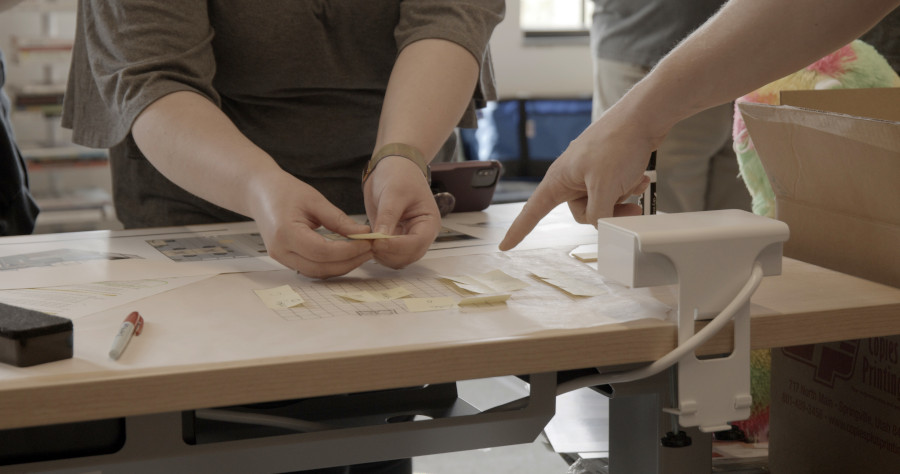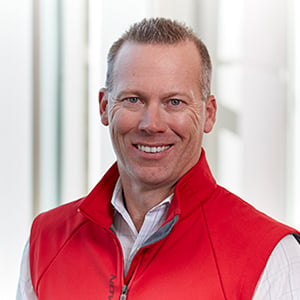- What's New
- Pricing & Purchasing
- Lead Times
- Literature & Samples
- Services & Warranties
- Careers
- Find a Rep
How to Support Workplace Well-Being: A Conversation with Wavetronix

In this interview with Chief Architect Scott Jensen, discover how Wavetronix prioritizes employee well-being at its new corporate campus.

In a recent interview, I spoke with Scott Jensen, chief architect at Wavetronix, an engineering company that develops radar systems to improve traffic. To support the company's rapid growth, they recently relocated to Springville, Utah. In addition to shaping the future of the transportation industry, Wavetronix is also a model employer for integrating well-being into the workplace.
In the following insights, we speak at length about how the company’s new campus puts employees first by prioritizing social interaction, fine-tuning a variety of indoor and outdoor workspaces, and instituting creative challenges to support workplace well-being.
This conversation has been lightly edited for clarity.
Jonathan Webb: Let’s begin by talking about the post-pandemic workplace. Did Wavetronix adopt a flexible work-from-home policy?
Scott Jensen: We did during COVID. We probably had 70% of our people working from home for a while. As things eased up, people started coming back. For a time, our chief executive officer, David Arnold, allowed some flexibility on that. Eventually, he said, “Okay, we don’t work from home. We work at the office.”
Webb: Have other companies in Utah adopted a work-from-home or flexible policy?
Jensen: We’ve seen that among some companies. It’s not necessarily health-driven – it’s more that the people working from home realize they can and want to do so.
Webb: What effect—negative or positive—has that had on Wavetronix’s ability to retain employees?
Jensen: We’ve noticed that you miss out on a lot of things when you’re always working from home, just by yourself. There’s the social aspect. Among the more critical considerations of being in the office is being able to work right alongside someone you’re mentoring, from day to day. If you’re doing everything remotely, there’s no way to see a person in action while they’re getting their work done or dealing with a certain project.
From our perspective, that really weakens the workforce. And it’s a rather downward spiral. People aren’t transferring their knowledge to the next generation. It’s a missed opportunity. Our CEO feels very strongly about that, to the point where he wants to attract employees that want to work in person.
Webb: What do you think causes leadership in your organization to think that way?

Jensen: With the way our business is structured, we spend time working with other people rather than sitting at our desks. Some of the best, most effective interactions happen when you walk over to get a glass of water or a cup of coffee and bump into somebody on the way.
We’ve set up our break rooms so that there are places where you can sit down one-on-one. We can sit down right there and talk for 10 or 15 minutes to get things sorted out. Those incidental meetings aren’t formal but they’re every bit as productive, if not more so, than a structured meeting.
Webb: At your new campus, are there things that didn’t go the way you thought they would from a building or architectural standpoint?
Jensen: We have an area called “The Loft” that was originally intended for pop-up meetings. We had movable dividers we pulled into place to separate the area into two to four meeting spaces of different sizes.
But we found that it just wasn’t acoustically isolated enough. It was very difficult to have a productive meeting because there would be crosstalk. For whatever reason, the sound from the TV monitor we used for video meetings traveled much further than the volume of someone talking in person. So that was a big fail.
Ultimately, we took out the dividers and put in low-impact, low-noise fitness equipment.
Webb: So, it’s a gym area now?
Jensen: It is! Physically, you’re doing your workout just 10 feet away from someone working at a desk on the other side of a screen wall. But it’s not noisy, so it’s not disruptive at all. It’s been pretty successful.
Webb: That’s really interesting. Whether it’s the amenity spaces or just the culture itself, wellness and well-being seem to be at the forefront of what Wavetronix is trying to do.
Jensen: With us, wellness is multifaceted, and well-being is one of those facets. For example, we have a high-deductible insurance policy, so everybody has a health savings account.
Something unique that Wavetronix does is make some contributions to employee HSAs based on monthly challenges that employees can do alone or with their spouses. One challenge might be to walk a certain number of steps per day. Another might be to eat five fruits and vegetables a day for a week. One that comes up frequently is to read for 30 minutes per day. The challenges are generally centered around getting out of your comfort zone.
Our wellness approach is not just about how many steps you get in; it's about total mental well-being.
Webb: That’s awesome. Looking to the future, can you talk about some of the more aspirational things that you’re looking to do with the new facility?
Jensen: There are a lot of great things we plan to do in the new building. “Neighborhood” concepts in the workspaces have been received really well. The same is true of the private studios or phone rooms where you can get away and work in solitude. We’re going to apply both of those to our new spaces.

Another thing we’re going to emphasize in the new building is the indoor-outdoor work environment. With the way we’ve designed the new building, we can open up our work environment to a courtyard. We can have meetings and workplaces outside.
There are nice plantings, so it’s a really pleasant environment. There will be heat sources so that we can meet outside in March and still be comfortable, rather than having to wait until April or May. We’ll be able to use them anytime except the dead of winter. Each floor also has decks that open into this type of outdoor space.
Webb: Do you make those spaces reservable where employees could treat them like any other reservable meeting room, or are they first-come, first-served?
Jensen: Most of them will be first-come, first-served. We’ll also have several greenhouses that people can reserve for meetings.
There will be plants growing in them, too. The one we have in the courtyard supports citrus plants, so it’ll grow some orange trees and lemon trees and the like. But there will be seating, so you can go in and work while being surrounded by citrus trees.
Webb: That’s super cool.
From Policies to Places, Well-Being Is Paramount
With spaces that foster collaboration, learning, and well-being, Wavetronix has created an environment that promotes both personal growth and business success.
Stay tuned for part two of my conversation with Scott Jensen, where we’ll dive into the company culture and unique relationship Wavetronix has built with the Springville community.
In the meantime, be sure to check out our full case study on the dynamic workspaces at Wavetronix.
Subscribe
Stay up to date with the latest trends and more.




